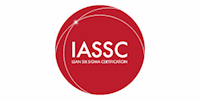
IASSC Lean Six Sigma Black Belt (exam included with retake) – 6 Months Access
Includes videos, practice test papers, official IAASC exam, live Q&A webinar with the tutor (Ph.D and Master Black Belt)
Hudson
Summary
Spread your payments over a maximum of 4 months.
- Exam(s) / assessment(s) is included in price
Add to basket or enquire
Overview
Key Points
- Provided by an IASSC fully Accredited Training Organisation (ATO): Hudson
- Exam fee paid for/included to sit the official IASSC exam and get certification from the IASSC
- Exam retake in the event you fail the exam on the first attempt
- Official exam can be sat at home or in the office
- Upon successful completion of the final exam, you will receive a certification from the IASSC confirming you are fully Six Sigma Black Belt certified
- 6 months access to course material
- Exam must be taken within 6 months of enrolment
Course Duration
- Total duration: 145 hours
Course features include...
Core Content:
- Video based course material: Fully narrated by the tutor, this includes hundreds of illustrations, graphics, charts, diagrams, and added animations to illustrate learning concepts.
- Study e-book: Certified Lean Six Sigma Black Belt eBook.
- DMAIC case studies: We have developed illustrated PDF case studies covering one topic from each DMAIC phase to help solidify your knowledge of the six sigma methodology.
- Video based project case study: This is a narrated case study focusing on the application of DMAIC tools and concepts in a commercial setting.
- Pre-recorded exam prep webinars: These DMAIC webinars cover the entire IASSC body of knowledge (BOK), and will help reinforce what you have learnt on the course and prepare you for the final exam.
Assessments:
- Interactive knowledge checks: As the name suggests, these are interactive knowledge checks – using drag and drop functionality. It’s a fun and easy way to help you grasp DMAIC.
- Interactive DMAIC simulation: This is an animated and narrated simulation of a six sigma project. You are prompted to choose the correct course of action throughout your project journey.
- Interactive quizzes: Test your knowledge after each DMAIC phase with this multiple choice set of quizzes.
- Practice test papers: These downloadable practice test papers will help prepare you for the final exam.
- IASSC Exam: The exam fee is covered in the course price.
- Exam insurance included: Fail the first attempt, get a second resit as part of this course
Resources:
- Interactive forums with other students: Reach out to other students, start your own posts, ask questions, discuss six sigma topics, and share your six sigma work.
- Downloadable six sigma templates: We have created a series of downloadable Excel templates that you can use during and after the course. You’ll find many of these discussed within the course. They can be used to apply your six sigma skills or utilised during a project.
- Live Q&A webinars: These run once a month with the tutor. They include access to previous webinars.
- Video based Minitab DMAIC exercises: This is an excellent resource to help cement your understanding of six sigma concepts, but also help you understand how to apply your six sigma skills in the real world. After watching the video tutorials, you’ll be prompted to perform the exercises.
What does this course cover?
In addition to covering the DMAIC methodology for preparation of the IASSC exam, this course also:
- Explains the reasoning and basis behind Six Sigma and Lean
- Will train you in the use of the Six Sigma tools and techniques
- Will provide you with exercises
- Will provide you with Minitab examples
- Will provide you with hints and tips on running a successful project
About the certification
Upon successful passing of the official IASSC exam, you will receive a certificate, suitable for framing, issued by the International Association for Six Sigma Certification. You will also receive the IASSC Marks/Logos and IASSC Marks/Logos Usage Policy which may be used on public profiles such as LinkedIn. You may use the designation ICBB (International Association for Six Sigma Certification Certified Six Sigma Black Belt), and IASSC Certified Black Belt or any approved variation of the designation after your name in accordance with the IASSC Marks Usage Policy.
At the end of this Six Sigma Black Belt certification course, you will be able to:
- Become a key stakeholder in leading, and implementing lean six sigma projects in your organization to Black Belt level
- Understand Six Sigma and DMAIC Methodology to Black Belt level
- Describe how to identify an improvement project in the Define phase to Black Belt level
- Explain how to measure process and product in the Measure phase to Black Belt level
- Identify the possible improvement actions for the performance of variations in the Improve phase to Black Belt level
- Define efficient operating levels for inputs and outputs in the Control phase to Black Belt level
- Identify the voice of customers, their requirements and needs
- Understand how to develop a strategy for Six Sigma approach
- Apply the DMAIC process to business issues to Black Belt level
Certification
Lean Six Sigma Certification
Course media
Description
Course Syllabus
Hudson Intro
- Hudson Intro
Welcome & Instructions on Using this Course
- Welcome & Instructions on Using this Course
- A Note on Accessing the Quizzes
- A Note on Attending the Webinars
IASSC Lean Six Sigma Black Belt: INTRODUCTION
- INTRODUCTION
IASSC Lean Six Sigma Black Belt: DEFINE PHASE
- DEFINE – Phase Intro
- 1.00 DEFINE – Course Structure
- 1.01 DEFINE – Introduction to Six Sigma
- 1.02 DEFINE – Steps & Tools
- 1.03 DEFINE – The Cost of Poor Quality
- 1.04 DEFINE – Six Sigma Metrics
- 1.05 DEFINE – Lean
- 1.06 DEFINE – Project Charter
- 1.07 DEFINE – Phase Summary
- 1.08 DEFINE – Case Study: Building a Business Case
- 1.10 DEFINE – Case Study: Pareto Chart Applications
- 1.11 DEFINE – Knowledge Check 1 (4 tasks)
- 1.13 DEFINE – Knowledge Check 2 (4 tasks)
- 1.12 DEFINE – Knowledge Check 3 (1 task)
- 1.14 DEFINE – Knowledge Check 4 (1 task)
- 1.15 DEFINE – Quiz
IASSC Lean Six Sigma Black Belt: MEASURE PHASE
- MEASURE – Phase Intro
- 2.00 MEASURE – Course Structure
- 2.01 MEASURE – Process Mapping Overview
- 2.02 MEASURE – Types of Process Map
- 2.03 MEASURE – Inputs to the Process
- 2.04 MEASURE – Cause & Effect Diagrams
- 2.05 MEASURE – X-Y Matrix
- 2.06 MEASURE – FMEA
- 2.07 MEASURE – Basic Statistics – Part 1
- 2.08 MEASURE – Basic Statistics – Part 2
- 2.09 MEASURE – Graphs
- 2.10 MEASURE – Measurement Systems Analysis (MSA) Overview
- 2.11 MEASURE – Measurement Systems Analysis – Continuous Data
- 2.12 MEASURE – Measurement Systems Analysis – Quantitative Data
- 2.13 MEASURE – Stability
- 2.14 MEASURE – Capability Analysis
- 2.14 (a) MEASURE – Calculating Capability Statistics (by Tamela Serensits – Master of Applied Statistics M.A.S)
- 2.15 MEASURE – Capability Analysis – Non-Normal Data
- 2.16 MEASURE – Phase Summary
- 2.17 MEASURE – Case Study: Measurement System Analysis
- 2.18 MEASURE – Knowledge Check 1 (4 tasks)
- 2.20 MEASURE – Knowledge Check 2 (4 tasks)
- 2.19 MEASURE – Knowledge Check 3 (1 task)
- 2.21 MEASURE – Knowledge Check 4 (1 task)
- 2.22 MEASURE – Quiz
IASSC Lean Six Sigma Black Belt: ANALYSE PHASE
- ANALYSE – Phase Intro
- 3.00 ANALYSE – Course Structure
- 3.01 ANALYSE – Overview
- 3.02 ANALYSE – Multi-vari Analysis
- 3.03 ANALYSE – Classes of Distributions
- 3.04 ANALYSE – Hypothesis Testing
- 3.05 ANALYSE – Sample Variance & Population Variance
- 3.06 ANALYSE – Continuous Output Data – Comparing Two Samples
- 3.07 ANALYSE – Continuous Output Data – Comparing More than Two Samples
- 3.08 ANALYSE – Continuous Output Data – Testing a Sample Against a Standard
- 3.09 ANALYSE – Tests for Non-Continuous Output Data
- 3.10 ANALYSE – Test for Equal Variance
- 3.11 ANALYSE – Phase Summary
- 3.12 ANALYSE – Case Study: The Box Plot
- 3.13 ANALYSE – Knowledge Check 1 (4 tasks)
- 3.15 ANALYSE – Knowledge Check 2 (4 tasks)
- 3.14 ANALYSE – Knowledge Check 3 (1 task)
- 3.16 ANALYSE – Knowledge Check 4 (1 task)
- 3.17 ANALYSE – Quiz
IASSC Lean Six Sigma Black Belt: IMPROVE PHASE
- IMPROVE – Phase Intro
- 4.00 IMPROVE – Course Structure
- 4.01 IMPROVE – Regression Analysis
- 4.02 IMPROVE – Multiple Regression
- 4.03 IMPROVE – Design of Experiments
- 4.04 IMPROVE – Full and Fractional Factorials
- 4.05 IMPROVE – Concept Generation
- 4.06 IMPROVE – Implementation
- 4.07 IMPROVE – Phase Summary
- 4.08 IMPROVE – Case Study: Regression Analysis
- 4.09 IMPROVE – Knowledge Check 1 (4 tasks)
- 4.11 IMPROVE – Knowledge Check 2 (4 tasks)
- 4.10 IMPROVE – Knowledge Check 3 (1 task)
- 4.12 IMPROVE – Knowledge Check 4 (1 task)
- 4.13 IMPROVE – Quiz
IASSC Lean Six Sigma Black Belt: CONTROL PHASE
- CONTROL – Phase Intro
- 5.00 CONTROL – Course Structure and Overview
- 5.01 CONTROL – Final Capability, Lean Controls
- 5.02 CONTROL – Control Plans
- 5.03 CONTROL – Center Line & Control Limit Calculation, Control Plans
- 5.04 CONTROL – Phase Summary
- 5.05 CONTROL – Case Study: The Control Plan
- 5.06 CONTROL – Knowledge Check 1 (4 tasks)
- 5.08 CONTROL – Knowledge Check 2 (4 tasks)
- 5.07 CONTROL – Knowledge Check 3 (1 task)
- 5.09 CONTROL – Knowledge Check 4 (1 task)
- 5.10 CONTROL – Quiz
IASSC Lean Six Sigma Black Belt: CONCLUSION
- CONCLUSION
Six Sigma DMAIC Project Case Study
- DMAIC Project Case Study: Reducing Shirt Defect Rates
Six Sigma DMAIC Simulation
- DMAIC Simulation
IASSC Lean Six Sigma Exam Prep Webinars
- IASSC Lean Six Sigma Exam Prep – DEFINE
- IASSC Lean Six Sigma Exam Prep – MEASURE
- IASSC Lean Six Sigma Exam Prep – ANALYSE
- IASSC Lean Six Sigma Exam Prep – IMPROVE
- IASSC Lean Six Sigma Exam Prep – CONTROL
IASSC Lean Six Sigma Black Belt: SAMPLE TEST PAPERS
- Sample Test Paper 1 – Questions and Answers
- Sample Test Paper 2 – Questions
- Sample Test Paper 2 – Questions and Answers
- Sample Test Paper 3 – Questions
- Sample Test Paper 3 – Questions and Answers
- Sample Test Paper 4 – Questions
- Sample Test Paper 4 – Questions and Answers
- Sample Test Paper 5 – Questions
- Sample Test Paper 5 – Questions and Answers
- Sample Test Paper 6 – Questions
- Sample Test Paper 6 – Questions and Answers
RESOURCE: Six Sigma Exam Reference Document
- IASSC Examination Reference Document
RESOURCE: Six Sigma DMAIC Excel Templates
- DEFINE Templates
- MEASURE Templates
- ANALYSE Templates
- IMPROVE Templates
- CONTROL Templates
RESOURCE: Six Sigma Minitab Exercises
- WEBINAR (with Tamela Serensits). TOPIC: Introduction to Minitab
- Minitab Exercises – Series Intro
- DEFINE Minitab Exercises
- MEASURE Minitab Exercises
- ANALYSE Minitab Exercises
- IMPROVE Minitab Exercises
- CONTROL Minitab Exercises
RESOURCE: Six Sigma Webinars
- Six Sigma: How to Apply it in the Real World
- Six Sigma: DMADV
About the exam
The IASSC Six Sigma Black Belt Certification exam is made up of 150 multiple choice and true/false questions. Your time allowance for the exam is 4 hours, although you may finish the exam sooner if you are able to.
In order to achieve the professional designation of IASSC Certified Black Belt (ICBB) from the IASSC, you must score a minimum of 580 points out of a total 750 points.
Who is this course for?
Lean Six Sigma Black Belt is most beneficial for organizations that encourage employees to take up Quality projects and ensure efficiency in all business/industry processes. This certification is most suited for:
- Quality and Process Managers, System Managers, Analysts, Auditors, Engineers and Executives who need to have a thorough understanding of Six Sigma to a Black Belt level. As part of your job role, you may also require the application of Six Sigma in process/quality improvements.
- Production Managers, Production Supervisors, and Customer Service Managers
- People wanting a thorough understanding of Six Sigma thinking and techniques
- Consultants who want to incorporate Six Sigma Black Belt into their service offerings
- Professionals working in the support functions like Finance, Purchase, Sales, Marketing, Training, Recruitment, Operations, IT-Support, Travel, etc.
Requirements
In order to become IASSC Black Belt certified, it is not necessary to be Green Belt certified beforehand, or have prior industry experience, or complete and submit projects as part of the Black Belt certification assessment. The only prerequisite is that you pass the official IASSC Black Belt exam.
Career path
- System Manager
- Auditor
- Production Manager
- Six Sigma Analyst
- Six Sigma Consultant
- Director of Operational Excellence
- Functional Project Lead
- Senior Project Manager
- Six Sigma Projects Manager
- Business Process Manager
- Lead Analyst/Project Manager
Questions and answers
Reviews
Currently there are no reviews for this course. Be the first to leave a review.
Legal information
This course is advertised on reed.co.uk by the Course Provider, whose terms and conditions apply. Purchases are made directly from the Course Provider, and as such, content and materials are supplied by the Course Provider directly. Reed is acting as agent and not reseller in relation to this course. Reed's only responsibility is to facilitate your payment for the course. It is your responsibility to review and agree to the Course Provider's terms and conditions and satisfy yourself as to the suitability of the course you intend to purchase. Reed will not have any responsibility for the content of the course and/or associated materials.



